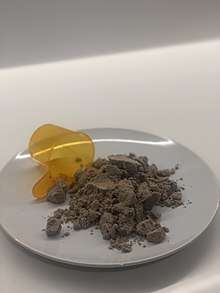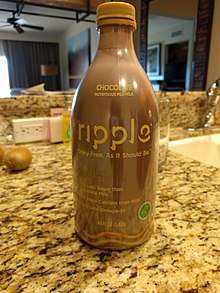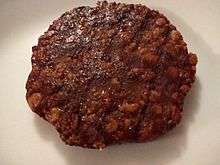Pea protein
Pea protein is a type of food. It is a source of protein derived and extracted in powder form from the yellow and green split peas, Pisum sativum, classified in the legume food group. It can be used as a supplement to increase an individual's protein or other nutrient intake, or as a substitution for other food products (i.e. the substitution of dairy milk for pea milk). It is also used as a functional ingredient in food-manufacturing, such as a thickener, foaming agent, or an emulsifier.[1]

It is extracted in a powder form and can be processed and produced in different ways:
- As an isolate - through the process of wet fractionation which has the highest protein concentration
- As a concentrate - through the process of dry fractionation which are lower in protein concentration; and
- In textured form, which is when it is used in food products as a substitute for other products, such as meat substitution (e.g. a “meat” patty).
Pea protein is a beneficial food source due to its low allergenicity, availability, and high nutritional value.[2] It can also help increase muscle mass,[3] contribute to weight-loss,[4] and it is a more environmentally friendly source of protein.[5]
Pea protein is criticised for its effects on digestion, taste, and high sodium content.[5] Depending on the method of processing, pea protein can contain certain levels of trypsin inhibitors, phytates, and lectins, which can cause negative side effects such as reduced nutrient uptake and intestinal damage.[1]
Composition
Pea protein is rich in nutrients such as protein and carbohydrates. Pea protein also contains various important vitamins and minerals and is low in fat.[2] While generally rich in protein, the actual protein content of peas is not always consistent. It is variable and influenced by both genetic factors and environmental factors (such as soil and climate in which the peas are cultivated).[6]
Pea protein contains all essential amino acids to meet human dietary needs.[7]
Typically, peas contain 23.1–30.9% protein,1.5–2.0% fat, and minor constituents such as vitamins, phytic acid, saponins, polyphenols, minerals, and oxalates.[8] They also contain several classes of protein: globulin, albumin, prolamin, and glutelin.[8] The proteins are mainly albumins and globulins, which account for 10-20% and 70-80% of the protein in the pea seed, respectively.[2] The albumins are water soluble and considered the metabolic and enzymatic proteins, while the globulins are salt soluble and act as the storage proteins for the seed.[9] Globulins can be further classified into legumin and vicilin, which belong to the 11S and 7S seed storage protein classes, respectively.[9] Legumin is a hexameric protein, and vicilin proteins are trimers.[2]
Pea seeds contain 60-65% carbohydrates mainly composed of oligosaccharides, monosaccharides, polysaccharides, and disaccharides.[10] The major carbohydrate fraction in peas is starch, which is the major storage carbohydrate in the cotyledons.[10]
Peas also contain high levels of dietary fibre, which consists of cellulose, gums, hemicellulose, pectin, mucilage, lignin, and resistant starches.[10] Dry pea has 17-27% dietary fibre depending on their cultivar, environment, and global growing region.[10]
In terms of sugars, pea seeds contain 5-6% sucrose and raffinose.[10] Sucrose ranges from 2.2% to 2.6%, whereas oligosaccharides, such as stachyose have a range of 1.3-3.2%, verbascose 1.2-4.0%, and raffinose 0.2-1.0% depending on cultivar and environment.[10] The fat content of pea seeds ranges from 1.2% to 1.8% depending on the cultivar and about 25% of fatty acids are composed of oleic acid (18:1) and 50% of linoleic acid (18:2).[10]
Pea seeds are also a rich source of minerals and vitamins. They contain high levels of the following:
- Calcium (850 parts per million),
- Magnesium (1450 parts per million),
- Phosphorus (5500ppm),
- Iron (60 parts per million),
- Zinc (43 parts per million) and,
- Copper (7 parts per million).[10]
In addition, peas are a rich source of folic acid, riboflavin, pyridoxine, niacin, pyridoxamine, niacin, and pyridoxal.[10]
Uses
Dietary supplement
The nutritional qualities contained in pea proteins can be used to supplement people with certain deficiencies, or people seeking to enrich their diet with nutrients. Peas are an excellent source of proteins, carbohydrates, dietary fibre, minerals, vitamins, and phytochemicals.[10] For example, pea protein can balance iron intake as it is high in iron.[11] In general, they contain over five milligrams per serve; a quarter of the recommended daily iron intake for adults.[11]
Dietary substitute

Pea protein can be used as a protein substitute for those who cannot consume other sources as it is not derived from any of the most common allergenic foods (wheat, peanuts, eggs, soy, fish, shellfish, tree nuts, and milk).[5] It may be used in baked goods or other cooking applications to replace common allergens. It is also processed industrially to form food products and alternative proteins such as alternative meat products, and non-dairy products. Manufacturers of alternatives include Ripple Foods, who produce a dairy alternative pea milk. Pea protein is also meat-alternatives such as Gardein and Beyond Meat, and egg alternatives such as Just Mayo.
Functional ingredient
Pea protein is also used as a low-cost functional ingredient in food manufacturing to improve the nutritional value and texture of food products.[1] They can also optimize the viscosity, emulsification, gelation, stability, or fat-binding properties of food. For example, The capacity of pea protein to form stable foams is an important property in cakes, souffles, whipped toppings, fudges, etc.[8]
Production
The manufacturing process of pea protein concentrates and isolates comprise of protein extraction, purification, and drying.[10] The industrial production of pea protein begins with the steps of cleaning and splitting the pea crop and then processing them further.
The cleaning process: cleaning uses equipment such as indent cleaners, which are used to remove impurities. This process ensures that any allergens, such as wheat, barley and other seeds are removed, as these products contain gluten.[10] If not removed, it would affect its classification as a gluten-free product if not removed.[10]
The splitting process: Following cleaning, the pea is split and “dehulled” using a dehuller.[10] The dehullers are a device that splits the pea seed and extracts the part of the whole seed which is the hull.[10]
Further processing: Following the splitting process, the split peas are further processed either into starch, protein, and flour fractions.[10]
Pea protein can be produced using two methods:
- The wet fractionation method; and
- The dry fractionation method.
Wet fractionation method
The wet fractionation method is used to produce pea protein isolates. Pea protein isolates generally contain a higher concentration of protein than pea protein concentrates. It involves the extraction of the protein at an alkaline pH.[6] An alkaline pH is usually between pH 9.5-10.5.[10] During the extraction of the protein, it is dispersed in water so that other components of the pea, such as carbohydrates, are also extracted via ultrafiltration or iso-electric precipitation.[6] Isoelectric precipitation is where the dissolved proteins are precipitated out of the aqueous phase and separated in a decanter.[12] This stage occurs at a pH of 4.0-5.0.[10] The protein is separated from the by-products in a hydroclone.[13] The precipitated protein (curd) is separated from the supernatant (whey) by filtration or centrifugation. The curd must be washed in order to remove residues of whey solubles.[6] Subsequently, the pH is neutralised and readjusted to 7, and a dry protein isolate is obtained with a final mechanical drying step, called spray-drying.[13]
Dry fractionation method
The dry fractionation method is used to produce pea protein concentrates. It involves dry milling technology; a traditional mechanical process used to reduce the particle size of split or whole peas into coarse or fine flours.[10] The outer shell of the pea is first dehulled, which is then milled via impact or jet milling to produce a flour.[13] This process relies on differential particle size and density within the milled flour.[13] Once milled, air classification is used, to separate the smaller protein-rich fragments from larger starch-rich granules or fibre-rich particles.[13] During this process, an air flow fluidizes the milled flour in a separation chamber.[13] A classifier wheel submerged in the bed selects the small particles and allows these to form the fine fraction.[13] Larger particles are rejected by the classifier wheel, leave the chamber at the bottom, and make up the coarse fraction.[13] Dry fractionation is a more sustainable method of processing as it does not require the use of water and energy is not required to dry the protein.[13]
Benefits
Health
The health benefits derived from pea protein are mainly from the concentration and properties of starch, protein, fibre, vitamins, minerals and phytochemicals in peas.[14]
Pea protein is high in fibre, which aids in mediating glycaemic response,[14] and is able to help prevent cardiovascular disease and reduce blood pressure by decreasing the levels of cholesterol and post-brandial triglyceride in humans.[15] Studies have found the intake of pea protein to reduce blood pressure in hypertensive rats and humans.[5] It can also be used for the prevention and control of diabetes as it has minimal effect on blood glucose levels and insulin response.[1] Due to its high fibre content, Pea protein has a 94% rate of digestibility which minimises stomach and gastrointestinal digestion issues, such as flatulence, and discomfort from bloating.[13] It’s starch content also aids digestibility as it is attributed to the nonavailability to amylases of starch granules enclosed in intact cell wall structures, the presence of anti-nutrients such as amylase inhibitors, phytates and phenolics.[14]
Pea proteins also contain high levels of folate. This can help increase dietary folate levels which is beneficial for people with anaemia and neural tube defects.[14] It also contains phenolic compounds, which are natural antioxidants that may help protect against diseases such as cancer and various inflammatory-related diseases.[14]
The amino acid profile of pea protein is also beneficial. It is high in lysine, which helps to convert fatty acids into energy,[5] and is important for the health of connective tissue.[13] It is a great source of arginine, which promotes healthy blood flow and heart health, as well as leucine, isoleucine, and valine, which promote muscle growth.[16]
Muscle mass
Pea protein can be used as a protein supplement to increase muscle mass. Increasing protein intake creates a positive acute postprandial muscle protein synthesis response and may create a positive long-term improvement in lean mass.[17] Pea proteins also contain Branched Amino Acids (BCAAs): leucine, isoleucine, and valine which helps to promote muscle growth.[18]
One study, involving a 12 week experiment on protein supplementation before and after resistance training, found that the consumption of pea protein promoted an increase in muscle mass, specifically in biceps brachii thickness.[3]
Weight loss
Pea proteins are also beneficial for weight loss. Pea proteins digest more slowly, which has a satiating effect and reduces hunger, which can contribute to weight loss.[4] The appetite-suppressing effects of peas may be related to high amounts of protein and dietary fibre, which may delay gastric emptying, attenuate glucose absorption and concentration and stimulate the release of appetite-regulating hormones.[10]
Environmental impact
When compared to the extraction of other proteins such as whey and soy, the production of pea protein utilises fewer resources which can impact the environment, such as the use of water and fertilisers.[5] Pea proteins require less water in their production and extraction process, making pea proteins a more environmentally sustainable food source than its counterparts. One study found that one kilogram of animal protein can only be obtained by feeding six kgs of plant protein.[13] Another study found that the water footprint per gram of protein for eggs, chicken meat, and milk is 1.5 times larger than for peas. In the case of beef, the water footprint per gram of protein is six times larger than for peas.[10]
Criticisms
Taste
Pea proteins have also been criticised for their taste, as they contain a compound called saponins, which can produce a bitter and metallic taste.[6]
Texture
Depending on the method of processing, pea protein can have a gritty texture.[19]
Composition

Pea proteins have high levels of phosphorus and potassium, which can have negative health implications.[5] For example, Beyond Meat burgers, which are a meat-free alternative to burger patties (made of pea protein), have 720 mg of potassium per burger.[5] Depending on the method of processing, some pea proteins can contain high levels of anti-nutritional properties such as phytates, lectins, and trypsin inhibitors, which have negative side effects.[1] Saponins and phytates, which may exhibit hypocholesterolaemic and anticarcinogenic activities.[14] Trypsin inhibitors decrease the digestion of the protein.[1] Lectins can impede the uptake of glucose, decrease nutrient transport, and create damage to the mucosal layer of the intestines by binding to carbohydrate molecules.[1] Phytates affect the bioavailability and digestibility of the protein by forming complexes with essential dietary minerals such as Iron, Zinc, and Calcium, affecting their absorption.[1]
References
- Sandberg, A. -S. (2011-01-01), Saarela, Maria (ed.), "15 - Developing functional ingredients: a case study of pea protein", Functional Foods (Second Edition), Woodhead Publishing Series in Food Science, Technology and Nutrition, Woodhead Publishing, pp. 358–382, doi:10.1533/9780857092557.3.358, ISBN 978-1-84569-690-0, retrieved 2020-05-28
- Lam, A. C. Y.; Karaca, A. Can; Tyler, R. T.; Nickerson, M. T. (2018-02-17). "Pea protein isolates: Structure, extraction, and functionality". Food Reviews International. 34 (2): 126–147. doi:10.1080/87559129.2016.1242135. ISSN 8755-9129.
- Babault, Nicolas; Païzis, Christos; Deley, Gaëlle; Guérin-Deremaux, Laetitia; Saniez, Marie-Hélène; Lefranc-Millot, Catherine; Allaert, François A. (2015-01-21). "Pea proteins oral supplementation promotes muscle thickness gains during resistance training: a double-blind, randomized, Placebo-controlled clinical trial vs. Whey protein". Journal of the International Society of Sports Nutrition. 12 (1): 3. doi:10.1186/s12970-014-0064-5. ISSN 1550-2783. PMC 4307635. PMID 25628520.
- Sanchez, Ana. "The best pea protein powder". chicagotribune.com. Retrieved 2020-05-28.
- Krefting, Jessica (September 2017). "The Appeal of Pea Protein". Journal of Renal Nutrition. 27 (5): e31–e33. doi:10.1053/j.jrn.2017.06.009. ISSN 1051-2276.
- Aiking, Harry; Boer, Joop; Vereijken, Johan, eds. (2006). "Sustainable Protein Production and Consumption: Pigs or Peas?". Environment & Policy. doi:10.1007/1-4020-4842-4.
- Gorissen, Stefan H. M.; Crombag, Julie J. R.; Senden, Joan M. G.; Waterval, W. A. Huub; Bierau, Jörgen; Verdijk, Lex B.; van Loon, Luc J. C. (2018). "Protein content and amino acid composition of commercially available plant-based protein isolates". Amino Acids. 50 (12): 1685–1695. doi:10.1007/s00726-018-2640-5. ISSN 0939-4451. PMC 6245118. PMID 30167963.
- Lu, Z. X.; He, J. F.; Zhang, Y. C.; Bing, D. J. (2019-08-20). "Composition, physicochemical properties of pea protein and its application in functional foods". Critical Reviews in Food Science and Nutrition. 0: 1–13. doi:10.1080/10408398.2019.1651248. ISSN 1040-8398. PMID 31429319.
- Burger, Travis G.; Zhang, Yue (April 2019). "Recent progress in the utilization of pea protein as an emulsifier for food applications". Trends in Food Science & Technology. 86: 25–33. doi:10.1016/j.tifs.2019.02.007. ISSN 0924-2244.
- Nadathur, Sudarshan R., editor. Wanasundara, Janitha P. D., editor. Scanlin, Laurie, editor. Sustainable protein sources. ISBN 978-0-12-802778-3. OCLC 983795948.CS1 maint: multiple names: authors list (link)
- CISSN, Joe Wuebben and Vince Kreipke, PhD, CSCS (2019-04-01). "The Complete Guide To Pea Protein Powder". Onnit Academy. Retrieved 2020-05-29.
- Hudson, B. J. F. (1994). New and developing sources of food proteins. Chapman & Hall. ISBN 0-412-58420-4. OCLC 635638429.
- Pelgrom, P. J. M. Dry fractionation for sustainable production of plant protein concentrates. ISBN 978-94-6257-235-5. OCLC 1016810947.
- Dahl, Wendy J.; Foster, Lauren M.; Tyler, Robert T. (2012-08-23). "Review of the health benefits of peas (Pisum sativum L.)". British Journal of Nutrition. 108 (S1): S3–S10. doi:10.1017/s0007114512000852. ISSN 0007-1145.
- "This Is Why Everyone Is Into Pea Protein Right Now". Shape. Retrieved 2020-05-29.
- "Pea Protein Powder: Nutrition, Benefits and Side Effects". Healthline. Retrieved 2020-05-29.
- Berrazaga, Insaf; Micard, Valérie; Gueugneau, Marine; Walrand, Stéphane (2019-08-07). "The Role of the Anabolic Properties of Plant- versus Animal-Based Protein Sources in Supporting Muscle Mass Maintenance: A Critical Review". Nutrients. 11 (8): 1825. doi:10.3390/nu11081825. ISSN 2072-6643.
- Lu, Z. X.; He, J. F.; Zhang, Y. C.; Bing, D. J. (2019-08-20). "Composition, physicochemical properties of pea protein and its application in functional foods". Critical Reviews in Food Science and Nutrition: 1–13. doi:10.1080/10408398.2019.1651248. ISSN 1040-8398.
- "HealthTalk: Pea protein is everywhere, is it healthy?". American Institute for Cancer Research. 2017-10-31. Retrieved 2020-05-29.